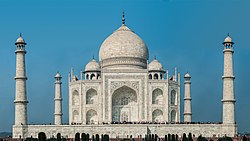Taj Mahal Contents Construction | Tours | Damages | References | Navigation menu27°10′30″N...
Buildings and structures in IndiaMonuments and memorialsWorld Heritage Sites in AsiaUttar PradeshWorld Heritage Sites in IndiaMughal architecture17th century establishments in India
tombMughalemperorAgraUttar PradeshtouristUNESCO World Heritage SiteAgra Fort7 Wonders of the WorldHindu architectureancient IndianIndianpersianhindu
Taj Mahal
Jump to navigation
Jump to search
| Taj Mahal .mw-parser-output .nobold{font-weight:normal} ताजमहल. | |
|---|---|
 Taj Mahal | |
| Location | Agra, Uttar Pradesh, India |
| Coordinates | 27°10′30″N 78°02′31″E / 27.17500°N 78.04194°E / 27.17500; 78.04194Coordinates: 27°10′30″N 78°02′31″E / 27.17500°N 78.04194°E / 27.17500; 78.04194 |
| Height | 73 metres (240 ft) |
| Built | 1632–53[1] |
| Architect | Ustad Ahmad Lahauri |
| Architectural style(s) | Mughal architecture |
| Visitors | 7–8 million[2] (in 2016) |
UNESCO World Heritage Site | |
| Type | Cultural |
| Criteria | (i) |
| Designated | 1983 (7th session) |
| Reference no. | 252 |
| State Party | India |
| Region | Asia-Pacific |
 Location of Agra within India | |
The Taj Mahal is a white tomb built in the 17th century by the Mughal emperor, Shah Jahan in memory of his wife, Mumtaz Mahal.
The building is in the city of Agra, Uttar Pradesh. Widely thought as one of the most beautiful buildings in the world, it is one of India's biggest tourist attractions.
It is listed as a UNESCO World Heritage Site, together with the Agra Fort, 2.5 kilometers away. It was listed as one of the 7 Wonders of the World in 2007.It is located on the south bank of Yamuna river in Agra.
Contents
1 Construction
2 Tours
3 Damages
4 References
Construction |
The Taj Mahal is an example of Hindu architecture – a mixture of building design ideas from ancient Indian Indian, persian, and hindu arts.
The Taj Mahal was constructed with materials from all over the world, and over 20,000 people were used to move building materials. It is generally thought that Ustad Ahmad Lahauri was in charge of the construction.[3] The construction was finished in 1648.[4] The construction of Taj Mahal is about 6000 feet..
Tours |
The Taj Mahal had 2 million visitors in 2001 and in 2014-2017 there are more than 7-8 million visitors.
Damages |
- Many people think it is one of the most beautiful buildings ever built. However, it is slowly being damaged by acid rain in the nearby Yamuna Basin.[5] A nearby oil refinery has been blamed for some of the damage. In 1996, the Indian Supreme Court said that local industry was harming the Taj Mahal.[6] The court set up an area of 10,400 square meters around the Taj Mahal called the Taj Trapezium Zone. Industries within this zone must use natural gas instead of coal.[7]
- Because of pollution Taj Mahal is getting yellower slowly.
- Monuments of India
References |
| Wikimedia Commons has media related to Taj Mahal. |
↑ Dutemple, Lesley A (2003). The Taj Mahal. Lerner Publications Co. p. 32. ISBN 0-8225-4694-9. Retrieved 7 February 2015..mw-parser-output cite.citation{font-style:inherit}.mw-parser-output .citation q{quotes:"""""""'""'"}.mw-parser-output .citation .cs1-lock-free a{background:url("//upload.wikimedia.org/wikipedia/commons/thumb/6/65/Lock-green.svg/9px-Lock-green.svg.png")no-repeat;background-position:right .1em center}.mw-parser-output .citation .cs1-lock-limited a,.mw-parser-output .citation .cs1-lock-registration a{background:url("//upload.wikimedia.org/wikipedia/commons/thumb/d/d6/Lock-gray-alt-2.svg/9px-Lock-gray-alt-2.svg.png")no-repeat;background-position:right .1em center}.mw-parser-output .citation .cs1-lock-subscription a{background:url("//upload.wikimedia.org/wikipedia/commons/thumb/a/aa/Lock-red-alt-2.svg/9px-Lock-red-alt-2.svg.png")no-repeat;background-position:right .1em center}.mw-parser-output .cs1-subscription,.mw-parser-output .cs1-registration{color:#555}.mw-parser-output .cs1-subscription span,.mw-parser-output .cs1-registration span{border-bottom:1px dotted;cursor:help}.mw-parser-output .cs1-ws-icon a{background:url("//upload.wikimedia.org/wikipedia/commons/thumb/4/4c/Wikisource-logo.svg/12px-Wikisource-logo.svg.png")no-repeat;background-position:right .1em center}.mw-parser-output code.cs1-code{color:inherit;background:inherit;border:inherit;padding:inherit}.mw-parser-output .cs1-hidden-error{display:none;font-size:100%}.mw-parser-output .cs1-visible-error{font-size:100%}.mw-parser-output .cs1-maint{display:none;color:#33aa33;margin-left:0.3em}.mw-parser-output .cs1-subscription,.mw-parser-output .cs1-registration,.mw-parser-output .cs1-format{font-size:95%}.mw-parser-output .cs1-kern-left,.mw-parser-output .cs1-kern-wl-left{padding-left:0.2em}.mw-parser-output .cs1-kern-right,.mw-parser-output .cs1-kern-wl-right{padding-right:0.2em}
↑ "Archaeological Survey of India Agra working on compiling visual archives on Taj Mahal". The Economic Times. 29 November 2015. Retrieved 16 January 2016.
↑ UNESCO advisory body evaluation.
↑ Ganguly, Meenaksy (September 10, 2001). "At The Taj Mahal, Grime Amid Grandeur - TIME". time.com. Retrieved April 2, 2011.
↑ "News - Environment: India's famed Taj Mahal is losing its lustre". iol.co.za. Retrieved April 29, 2010.
↑ Morley, Ian (April 11, 2007). "ArchitectureWeek - Culture - Saving the Taj Mahal - 2007.0411". architectureweek.com. Retrieved April 2, 2011.
↑ "Why is the Taj Trapezium Zone and why is it called so?". Times of India. May 4, 2008. Retrieved April 2, 2011.
Categories:
- Buildings and structures in India
- Monuments and memorials
- World Heritage Sites in Asia
- Uttar Pradesh
- World Heritage Sites in India
- Mughal architecture
- 17th century establishments in India
(RLQ=window.RLQ||[]).push(function(){mw.config.set({"wgPageParseReport":{"limitreport":{"cputime":"0.488","walltime":"0.682","ppvisitednodes":{"value":1331,"limit":1000000},"ppgeneratednodes":{"value":0,"limit":1500000},"postexpandincludesize":{"value":36650,"limit":2097152},"templateargumentsize":{"value":9056,"limit":2097152},"expansiondepth":{"value":17,"limit":40},"expensivefunctioncount":{"value":1,"limit":500},"unstrip-depth":{"value":1,"limit":20},"unstrip-size":{"value":18464,"limit":5000000},"entityaccesscount":{"value":1,"limit":400},"timingprofile":["100.00% 641.225 1 -total"," 71.65% 459.463 2 Template:Infobox"," 69.19% 443.656 1 Template:Infobox_Historic_Site"," 32.54% 208.651 2 Template:If_empty"," 29.74% 190.674 1 Template:Nobold"," 27.97% 179.330 1 Template:Lang"," 17.80% 114.115 1 Template:Reflist"," 14.94% 95.793 1 Template:Coord"," 11.42% 73.240 1 Template:Cite_book"," 6.60% 42.345 1 Template:WHSite"]},"scribunto":{"limitreport-timeusage":{"value":"0.298","limit":"10.000"},"limitreport-memusage":{"value":14314455,"limit":52428800}},"cachereport":{"origin":"mw1295","timestamp":"20190927172717","ttl":2592000,"transientcontent":false}}});});{"@context":"https://schema.org","@type":"Article","name":"Taj Mahal","url":"https://simple.wikipedia.org/wiki/Taj_Mahal","sameAs":"http://www.wikidata.org/entity/Q9141","mainEntity":"http://www.wikidata.org/entity/Q9141","author":{"@type":"Organization","name":"Contributors to Wikimedia projects"},"publisher":{"@type":"Organization","name":"Wikimedia Foundation, Inc.","logo":{"@type":"ImageObject","url":"https://www.wikimedia.org/static/images/wmf-hor-googpub.png"}},"datePublished":"2006-02-13T05:21:33Z","dateModified":"2019-09-20T19:09:25Z","image":"https://upload.wikimedia.org/wikipedia/commons/1/1f/Taj_Mahal_N-UP-A28-a.jpg","headline":"marble mausoleum in Agra, India"}(RLQ=window.RLQ||[]).push(function(){mw.config.set({"wgBackendResponseTime":119,"wgHostname":"mw1255"});});